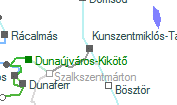The Bzmot 238 near Kunszentmiklós-Tass

Photo by: Takács Bence
Captured at: 2006:09:04 17:05:13
861 views
Practically this is the area of the station, the delta-track providing two-way access of the branch line to the main line. There was a bridge over the Danube at Dunaföldvár (it’s still there, but open only for road vehicles) that handled heavy traffic, both for the Dunaújváros steel mill and as a backup route if the Budapest bridge was closed.
The signal in the bacground is the repeat signal of the second entry signal of Kunszentmiklós-Tass station. In Hungary, to make safety systems simpler, sometimes a station is divided into segments and each segment has it’s own entry signal, so a train can enter a station twice. Because the two entry signals are usually no more than five hundred metres after eachother, this cannot be used as a "block", but if the track is clear after the first entry signal, but there are movements after the second entry signal, the controller can gain time by letting the train come until the second entry signal. For example here the delta track is never used now, but was seldom used even in the past, so the points of the delta are always clear, but the mainline station can have more important things to do than handle a branch line passanger train. In this case, if there wasn’t a second entry signal, the Bz would have to stop about a kilometre away from the station, which takes plenty of time to cover, and time is what a controller doesn’t have when the station is crowded.
The repeat signal is used when the driver (for example because of a covering building, tree or anything else) cannot see the main signal from at least two hundred (or more, depending on speed) metres.
Photo by Takács Bence
Copyright 2005-2014. www.benbe.hu. Railway photography gallery of Takács Bence.


